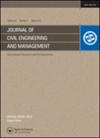脆弱性视角下基于模糊petri网的复杂工程项目风险评价
IF 3.7
3区 工程技术
Q1 ENGINEERING, CIVIL
引用次数: 0
摘要
传统的工程风险管理由于其构成要素和内外部环境的动态性,已经无法适应其复杂性和可变性。脆弱性作为一个与风险密切相关的概念,由于其隐蔽性而被传统的风险管理所忽视。本研究试图对复杂工程项目的脆弱性进行独立量化和评价,探索风险与脆弱性因素之间的传导机制。同济大学大型工程案例研究中心(MPCSC)选取了中国20个不同类型的大型工程项目作为案例研究。识别和分析了每个项目的脆弱性和风险因素。通过模糊Petri网建立了脆弱性和风险影响的机制模型。通过反向标记方法,确定了4条主要的漏洞风险关键路径。考虑脆弱性影响的工程项目风险综合评价是本文研究的重点。本研究从新的角度诠释了复杂工程风险的认知和评价,丰富了工程风险管理的内涵,为复杂工程项目的风险管理和决策提供了参考。本文章由计算机程序翻译,如有差异,请以英文原文为准。
RISK ASSESSMENT OF COMPLEX ENGINEERING PROJECT BASED ON FUZZY PETRI NET UNDER THE PERSPECTIVE OF VULNERABILITY
Traditional engineering risk management has been unable to adapt to the complexity and variability due to its constituent elements and dynamic nature of internal and external environments. Vulnerability, as a concept closely related to risk, has been neglected in the traditional risk management due to its hidden characteristics. This study attempts to quantify and evaluate vulnerabilities of complex engineering projects independently and explore the transmission mechanism between risk and vulnerability factors. Twenty different types of large-scale engineering projects in China were selected as case studies from the Mega Project Case Study Center (MPCSC) of Tongji University. Vulnerability and risk factors of each project were identified and analysed. A mechanism model was developed to explore the impacts of vulnerabilities and risks through ta Fuzzy Petri Net. Four main vulnerability-risk critical paths were identified through the reverse labelling method. The overall evaluation of engineering project risks considering the impacts of vulnerabilities is the highlight of this paper. This study interprets the cognition and evaluation of complex engineering risks from a new perspective, enriches the connotation of engineering risk management, and provides a reference for risk management and decisionmaking of complex engineering projects.
求助全文
通过发布文献求助,成功后即可免费获取论文全文。
去求助
来源期刊

Journal of Civil Engineering and Management
ENGINEERING, CIVIL-
CiteScore
6.70
自引率
4.70%
发文量
0
审稿时长
1.7 months
期刊介绍:
The Journal of Civil Engineering and Management is a peer-reviewed journal that provides an international forum for the dissemination of the latest original research, achievements and developments. We publish for researchers, designers, users and manufacturers in the different fields of civil engineering and management.
The journal publishes original articles that present new information and reviews. Our objective is to provide essential information and new ideas to help improve civil engineering competency, efficiency and productivity in world markets.
The Journal of Civil Engineering and Management publishes articles in the following fields:
building materials and structures,
structural mechanics and physics,
geotechnical engineering,
road and bridge engineering,
urban engineering and economy,
constructions technology, economy and management,
information technologies in construction,
fire protection, thermoinsulation and renovation of buildings,
labour safety in construction.
 求助内容:
求助内容: 应助结果提醒方式:
应助结果提醒方式:


